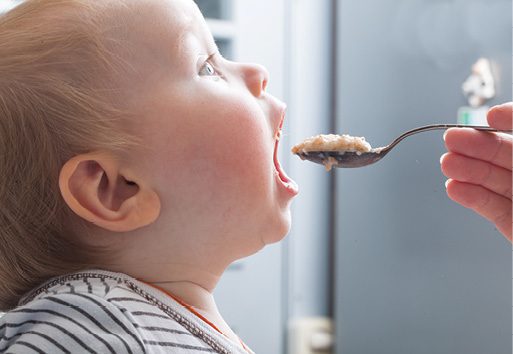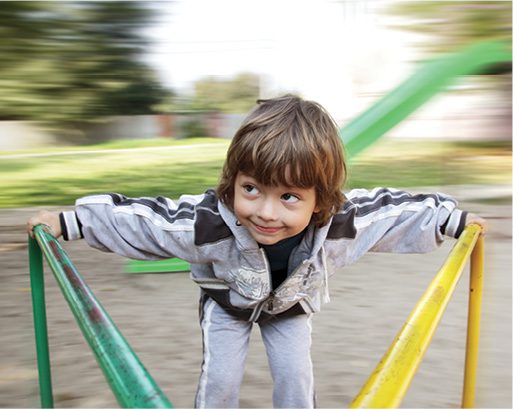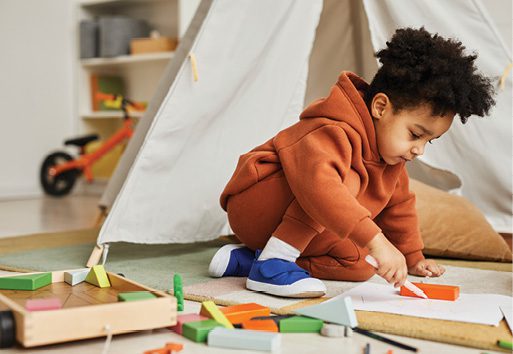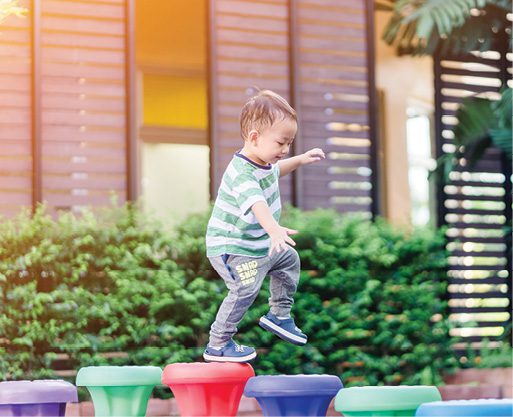Jeanette Luedders Jones, Vallejo, California
Ira Glovinsky, Fielding Graduate University
Abstract
Interoception, the eighth sensory system, connects emotional regulation, perspective-taking, and problem solving— foundational skills needed for future success. There has been limited research on interventions with children encompassing interoceptive awareness, the awareness and perception of sensations from inside the body. The information gathered from a recent study examined how participants experienced a bidirectional, reflective, online intervention program on interoceptive awareness and how it affected caregiver–child relationships. Positive interactions, attunement, awareness of interactions with others, and the ability to watch for cues materialized in the participants’ stories, emphasizing the need for further education for caregivers and training programs about development for early childhood professionals.
The introduction of interoceptive concepts–the awareness of one’s inner bodily sensations—in early childhood will change the paradigms of education and mental health interventions. Interoceptive awareness is critical to the development of self-regulation. Without being aware or being able to discriminate, identify, or know what one is feeling, individuals are at the mercy of these states and have enormous difficulty developing control, self-control, and self-regulation (Kopp, 1982). The critical importance of developing interoceptive awareness can be seen in the increase in disruptive behaviors and mood disorders in younger and younger children. From a survey of United States prekindergarten child care providers, Gilliam and Shahar (2006) found that there were 3.6 times as many children being expelled from preschool programs as were being expelled from kindergarten through grade 12, inclusively. This country is still experiencing an “explosion” of early childhood expulsions as well as teachers feeling untrained to deal with disruptive behaviors. Thus, a huge concern in early education today is the “wear and tear” on teachers from dysregulated young children.
What Are Interoception and Interoceptive Awareness?
Sometime during early childhood, people begin to attach five sensory words to their experiences. “Smell the flowers,” “Does that taste good?” “See the bird in the tree,” “Don’t touch that,” “Do you hear the noise?” These sensory words become part of everyday vocabulary. Some learn that the vestibular system provides a stable base enabling people to do complex tasks and functions that give gravitational security and that the proprioceptive system allows people to accomplish smooth, coordinated, and well carried out movements and to develop body schema and maps. Most people are unfamiliar with the “eighth sensory sense,” interoception.
Interoception has been defined as “the process of how the nervous system senses, interprets, and integrates signals originating from within the body” (Quigley et al., 2021; Schmitt & Schoen, 2022). The term was initially introduced by a neurologist, Charles Sherrington, in 1906 as “sensations from the interior of the body, especially the viscera” (as cited in Craig, 2015, p. 3). Interoception is involved in embodied self-awareness, sensing our breathing, digestion, hunger, arousal, pain, emotion, and fatigue, and is a process that links the brain’s circuitry to internal organs of the body (Fogel, 2013). The process of interoception is bidirectional as the body sends messages to the brain and the brain sends messages to the body. Interoception is an integral component of the internal body balance known as homeostasis. There are two kinds of interoceptive messages, homeostatic and affective. The homeostatic messages include those such as hunger, thirst, pain, and having to use the bathroom. Affective messages include happy, mad, sad, surprised, etc. Interoceptive signals originate in the body and then are registered in the central nervous system. Thus, people have moment-to-moment physiological representations of what their bodies are experiencing and representing. These representations are both preconscious and conscious (Quadt et al., 2018; Schmitt & Schoen, 2022; Tsakiris & De Preester, 2018). In addition, interoceptive awareness is the recognition of one’s inner body sensations involving the sensory processes of receiving, accessing, and appraising internal bodily signals (Craig, 2009).
The awareness of interoceptive states affects functioning throughout the day. The awareness and unawareness of one’s emotions effects one’s interpersonal relationships and functioning in school and occupations. An individual’s sensory channels are unique in that they have thresholds, meaning there are some who may not register these interoceptive messages, some who register these sensations very sharply, and some who have mild to moderate experiences of their sensations. Interoceptive signals enable people to give reasons and labels for the sensations they experience.
Interoception is the foundation of educational and therapeutic work; it is also integral to ongoing work with children, although not a familiar concept to many professionals across disciplines. Adults often assume that children know what their interoceptive signals are, or they disregard those signals in their work with children. We are finding that the signals are critical to understanding children’s inner experiences at all ages (see Box 1). Interoceptive signals can direct clinical and educational work.
Box 1. Understanding Inner Experiences
The following examples from Dr. Glovinsky’s clinical practice demonstrate the link between interoception and children’s mood and behavior:
• A young girl exclaimed, “I’m so frustrated, so frustrated!” Looking at her I was surprised at her vocabulary and responded, “Such a big word. What does frustrated mean?” She replied, “I don’t know, but my mommy and daddy say it all the time!”
• A 14-year-old was yelling in the waiting room outside my office, “I’m so angry, so mad!” Just before he entered the office, he yelled again, “I’m so angry.” He and his parents sat down in the office and his mother said, “Why don’t you tell Dr. G. what you’re so mad about!” I put up both of my arms and hands and said, “Hold on. You said you were angry, right?” He replied, “Yeah, I’m really angry!” I said, “How do you know you’re angry?” After a brief pause, he looked at me and said, “I don’t know. I can’t explain it.”
• A young boy who had had two different previous therapists came into my office and told me that neither therapist “got it.” When I asked him to explain, he said that they were “trying to teach me about anger and told me that it’s like a train coming down the track. When you turn your head to see the train coming closer, the light on the train gets bigger and bigger. Anger works like that; you can feel it get bigger and bigger.” Then he continued, “I don’t feel anger like a train coming down the track. I feel anger right before I explode.” His previous therapists were teaching him how to breathe deeply when he experienced the first signals that he was angry. Only, he didn’t feel the build-up of the anger. He seemed to explode out of nowhere!
Background Research
To date, there has been little research on interoception and interoceptive awareness in young children. However, the development of self-regulation and school readiness involves interoception and no one has researched this. A child needs to identify sensations and feelings to do something about them. There is a process of discriminating and identifying sensations, then clustering sensations into feeling words that enable people to control their actions.
Much of the interoception research presently includes interventions to support older children and adults or exists in neuroscience and neuroanatomy journals. Research that exists in the intervention literature includes Kelly Mahler (2016) who has compiled her developmental and experimental research into a curriculum on interventions for children. Mahler recently developed online modules for parents of early learners, and Cara Koscinski (2018) wrote a book for adults and children, Interoception: How I Feel: Sensing My World From the Inside Out. Mahler and Koscinski provide strategies and interventions to assist with the development of interoceptive awareness. Charlotte Brownlow and Emma Goodall (2022) have published work discussing interoception and self-regulation to increase childhood engagement in learning.
An Intervention Program for Interoceptive Awareness
If professionals work with parents and providers to help them to identify their own sensations and feelings, and educate them to help children understand their interoceptive messages early in development, they may provide parents, providers, and children with tools to then verbalize what they are experiencing internally. These skills will help children to verbalize rather than act out their feelings. A successful program for parents of young children may make a difference in the large number of children who are being expelled from early childhood programs. In addition, such programs may have an impact on the development and emergence of mood or behavioral problems in young children.
Although there is some research on interoceptive awareness available to professionals in the field of early childhood, there are few intervention programs specifically designed to meet the needs of parents and caregivers in a bidirectional and synchronous manner focusing on the concepts. My (JLJ) intervention program involved the delivery of strategies and information to parents to influence their parent–child relationships and, ideally, their child’s interoceptive awareness. The information about interoceptive awareness benefited parents and caregivers of children in early infancy and toddlerhood. With the understanding of their child’s capabilities and development, parents and caregivers were more attuned to the needs of their infants and toddlers and reported a more synchronous relationship as their child developed. The program, which received exemplary feedback, was originally designed for parents of children between birth and 3 years old, although it has since been altered to include child care providers and teachers of infant, toddler, and preschool-aged children. Background information on interoception and activities to assist participants with developing interoceptive awareness in their infants and toddlers was shared via a videoconferencing tool. Group conversations, presentations by the program designer (JLJ), and videos were used within the program to enhance learning.
The intervention program allowed participants within a small group (9 participants) to listen, learn, brainstorm, and dialogue about their children and share activities that they found helpful for themselves and their children. Participants were given activities each week to complete either themselves, such as an interoceptive awareness questionnaire, or strategies to practice with their children, such as talking aloud about their bodily sensations and connecting those sensations to their emotions.
Components of the Intervention Program
The study focused on five core components of building relationships—attunement, synchrony, contingency, co-regulation, and reflective parenting as described in the following sections:
Attunement
- tailoring interactions to meet each child’s physical and emotional needs, and allowing adults to promote responsiveness, warmth, and engagement in their relationships with a child (Delahooke, 2019)
- impacts a child’s awareness of their physiological body states or their interoceptive attunement (Craig, 2003)

Interoceptive signals originate in the body and then are registered in the central nervous system. Photo: shutterstock/OMfotovideocontent
Synchrony
- The interaction between a caregiver and an infant is a pattern of behavior coordination and a fundamental aspect of social life, and its development is strengthened through behaviors during social contact, such as gaze, affect, and heart rhythms (Kinreich et al., 2017).
- described as a “dance” between partners as they move together or as infants shift from disinterest to attentive, and caregivers shift their attention from quiet to positive arousal and stimulation (Feldman, 2007, p. 340)
Contingency
- begins in early infancy, focuses on social–emotional development, and researchers express it as being the most fundamental of an infant’s arsenal of innate modules for interpreting early sensory stimulation (Gergely & Watson, 1999)
Co-regulation
- Co-regulation is described by Fogel (1993) in his book Developing Through Relationships: Origins of Communication, Self, and Culture as the dynamic balancing act by which a smooth social performance is created out of the continuous mutual adjustments of action between partners.
- Delahooke (2019) delineated co-regulation as providing emotional support by attuning to and supporting another person through our presence.
Reflective Parenting
- Reflective parenting develops through reflective functioning, the developmental acquisition that permits people to respond not only to another person’s behavior but to the other person’s conception of others’ beliefs, feelings, attitudes, desires, hopes, knowledge, or the ability to make sense of one another (Fonagy et al., 2002).
- Reflective parenting involves two-way perspective-taking as a parent, seeing the world from a child’s perspective and a parent’s perspective (Pally, 2017).

Interoceptive signals enable people to give reasons and labels for the sensations they experience. Photo: shutterstock/Chepko Danil Vitalevich
Results and Significance of Study
At the completion of the program, participant interviews revealed that the sequence of learn, implement, practice, and reflect led to an increase in awareness and skills. Interviews included questions about participants’ abilities to connect their bodily sensations to feelings, decision-making, intuition, perspective-taking, and empathy skills. Participants’ use of storytelling and situational examples described their interpretation of interoceptive awareness. Ideas shared included positive interactions, attunement, awareness of their interactions with others, the ability to watch for cues, and positive experiences of connecting their bodily sensations to their feelings by discussing their self-regulation and self-awareness skills and how those skills affected their interactions with their children and others. Participants gave numerous examples of how they figured out how to stay regulated, be self-aware, reflect on their empathy and perspective-taking skills, determine what strategies helped them, such as mindfulness or active listening, and understand their bodily signals (see Box 2). By learning new ways to understand themselves through the learned concepts, their perception of their child(ren) improved, directly transforming their caregiver–child relationships. Participants highlighted their abilities to be more in tune with their child(ren) while staying present in the moment and matching their emotions. They expressed the support they provided to their child(ren) by helping and guiding them with their emotions.
Box 2. Participant Experiences
The following participants’ quotes from Dr. Luedders Jones’ study describe their understanding, application, and experiences:
- The program “enhanced relationships” and was “somatic learning... really tuning into your body and how you’re responding to situations...the resources made me more aware of how my body responds to certain emotions, so I thought it was a really helpful thing, just in general for relationships, but also to tune into how you respond to kids and how they are also responding.”
- “To be aware of yourself...when you’re hungry, angry, lonely, or tired [and] how that can affect your emotional state and when that affects your emotional state, you might...not act in a way that you feel is appropriate at the moment.”
- [The program] “helped me to be more observant, you know, of everything that’s going on with her, but I think it takes practice because everybody’s different...I’m definitely more patient with her now, and I try to listen to her more with as little words that she [has], I still listen to her, like she said ‘ow, ow, ow,’ and pointing, I will listen to her more instead of just ignore her.”
- The sportscasting strategy is “very applicable and I’ve seen success with doing it because he’ll start to calm down, he’s like feeding off of and seeing a lot of my cues.”
- “Personally, thinking about different actions that I do—like we said many times, urinating, drinking, and being thirsty—trying to put that into words to better explain to her” and “just learning how to talk about and use words to explain emotions.”
- “The main thing about the whole course is that I felt like it was really being in touch with your body during your activities [and] how you respond at any time...[a] simple way of staying present.”
- “How to be in tune [with] my internal body functions and also signals that my body is giving...my heart is beating very fast, what can I do to help myself regulate?
All participants discussed the importance of reflection and profited from it in meaningful ways. They expressed how pondering on past situations, both their recent and historical pasts, benefited them presently. Participants commented on how they could also look at unsuccessful experiences and learn from them using the information they gained in the program. For instance, participants described how they previously did not take the time to view events from their child’s perspective or empathize with how their child may have felt in challenging situations.
Another component that emerged in participants’ lived experiences was the importance of how a program is structured and conducted. Participants discussed how the small group dynamics affected their willingness to participate and share personal experiences with others. They also stated how important it was to hear others’ perspectives and how listening to the experiences of others enhanced their understanding of concepts. Caregivers created relational improvements while continually adjusting their strategies to meet their child’s evolving developmental needs. One word that encapsulates the effects of the program on relationships is interactions. The term interaction might best be described as communication or direct involvement with someone or something, or reciprocal action or influence. Caregivers expressed the positive interactions in which they engaged with their child(ren) and attributed these experiences to the program. They described how their understanding of the presented information prompted them to look at their child(ren) differently, watch for their child(ren)’s cues, and have a better awareness of how their emotions affected their interactions. All of these led to successful outcomes in their relationships, and each participant acknowledged how their feelings about their relationships with their child(ren) had improved.
Moving Forward
The following activities and goals are some next steps in working with parents and professionals to better understand and support interoceptive development in young children:
- Increase awareness and knowledge about the terms and the importance of interoception and interoceptive awareness.
- Educate parents and providers to begin to identify sensations in their bodies and recognize them in their everyday experiences.
- Develop further training programs for parents and young children to help them to identify, discriminate, and give names to sensations that they experience in everyday activities.
- Work with preschool teachers, child care providers, and other early childhood personnel so that they can work with children during the day and integrate interoceptive activities into their curriculum.

The development of self-regulation and school readiness involves interoception. Photo: shutterstock/SeventyFour
- Collect data from parents and teachers in a pre- post- model to determine if there are changes in children’s behaviors because of putting these activities into operation in the classroom.
- Collect data on the effect of interoceptive awareness training on children’s mood and disruptive behaviors.
Learn More
Caregiver Responses to an Intervention Focusing on Interoceptive Awareness in Their Infants and Toddlers
J. Luedders Jones
www.proquest.com/openview/8d68b661c8a86a5e63c3181f059378ea/1?pq-origsite=gscholar&cbl=18750&diss=y
Multidimensional Assessment of Interoceptive Awareness (MAIA)
https://osher.ucsf.edu/research/maia
Kelly Mahler
www.kelly-mahler.com
Mentalizing Homeostasis: The Social Origins of Interoceptive Inference A. Fotopoulou & M. Tsakiris (2017)
Neuropsyhcoanalysis, 19(1), 3–28
Children’s Books
Are You Feeling Cold, Yuki?
K. I. Al-ghani and Haitham Al-ghani (2021) Jessica Kingsley Publishers
In My Body, I Feel: A Story About the Felt Sense of Emotions
Jackie Flynn (2020)
Listening to My Body: A Guide to Helping Kids Understand the Connection Between Their Sensations (What the Heck Are Those?) and Feelings so That They Can Get Better at Figuring out What They Need
Gabi Garcia (2017)
Skinned Knee Publishing
Joey’s Heart
Renee Marie Allen and Faiza Farooq (2022)
Author Bios
Jeanette Luedders Jones, PhD, is a credentialed early childhood special education teacher in California and completed her doctoral degree in infant and early childhood development with an emphasis in mental health and developmental disorders. Over her 18-year early childhood career, Dr. Luedders Jones has taught and coached in inclusive preschool classrooms and provided early intervention services to families of infants and toddlers with developmental delays. She currently facilitates a course about children with special needs at Solano Community College and provides local (Solano Family and Children Services) and state (California Association for the Education of Young Children) workshops for parents and early childhood providers on various topics including interoceptive awareness, reflective practice, inclusive practices, and trauma-informed practices. Dr. Luedders Jones’ present projects include facilitating reflective dialogue on interoceptive awareness and reflective practice with Child Start, Inc., staff through a First 5 Grant and continuing to develop training opportunities to enhance interoceptive awareness in young children with Dr. Glovinsky. Email: jlueddersjones@gmail.com
Ira Glovinsky, PhD, is a licensed psychologist practicing in Ann Arbor, Michigan. He specializes in early childhood mood disorders. Dr. Glovinsky is an adjunct professor at Fielding Graduate University in the Infant and Early Childhood Program with a specialization in infant mental health. He is also associate adjunct professor in the Early Childhood/Arts Education Program at Brooklyn College in New York. Dr. Glovinsky has co-authored two books with Dr. Stanley Greenspan on mood disorders and bipolar patterns in children and has written peer-reviewed articles on pediatric bipolar disorder. Dr. Glovinsky is presently focusing on reflective practice with a law practice in Washington State and reflective practice with home visitors working with infants and toddlers in foster care in California. His present special interest is in developing a training program on interoception for parents of infants and toddlers with
Dr. Luedders Jones. Email: ira1834@sbcglobal.net
Suggested Citation
Luedders Jones, J., & Glovinsky, I. (2022). PERSPECTIVES: Breaking new ground—Interoceptive awareness in early childhood: Connecting bodily sensations to emotions. ZERO TO THREE Journal, 43(2), 47–52.
References
Brownlow, C., & Goodall, E. (2022). Interoception and regulation: Teaching skills of body awareness and supporting connection with others. Jessica Kingsley Publishers.
Craig, A. D. (2003). Interoception: The sense of the physiological condition of the body. Current Opinion in Neurobiology, 13(4), 500–505.
Craig, A. D. (2009). How do you feel—now? The anterior insula and human awareness. Nature Reviews Neuroscience, 10(1), 59–70.
Craig, A. D. (2015). How do you feel? An interoceptive moment with your neurobiological self. Princeton University Press.
Delahooke, M. (2019). Beyond behaviors: Using brain science and compassion to understand and solve children’s behavioral challenges. PESI.
Feldman, R. (2007). Parent-infant synchrony: Biological foundation and developmental outcomes. Current Directions in Psychological Science, 16, 340–346.
Fogel, A. (1993). Developing through relationships: Origins of communication, self, and culture. University of Chicago Press.
Fogel, A. (2013). Body sense: The science and practice of embodied self-awareness. W. W. Norton.
Fonagy, P., Gergely, G., Jurist, E., & Target, M. (2002). Affect regulation, mentalization, and the development of the self. Other Press.
Gergely, G., & Watson, J. S. (1999). Early socio–emotional development: Contingency perception and the social-biofeedback model. In P. Rochat (Ed.), Early social cognition: Understanding others in the first months of life (pp. 101–136). Lawrence Erlbaum Associates Publishers.
Gilliam, W. S., & Shahar, G. (2006). Preschool and childcare expulsion and suspension. Infants & Young Children, 19(3), 228–245.
Kinreich, S., Djalovski, A., Kraus, L., Louzoun, Y., & Feldman, R. (2017). Brain-to-brain synchrony during naturalistic social interactions. Scientific Reports, 7(1), 17060.
Kopp, C. (1982). Antecedents of self-regulation: A developmental perspective. Developmental Psychology, 18(2), 199–214.
Koscinski, C. (2018). Interoception: How I feel: Sensing my world from the inside out. Pocketbooks for Special Needs.
Mahler, K. J. (2016). Interoception: The eighth sensory system: Practical solutions for improving self-regulation, self-awareness and social understanding of individuals with autism spectrum and related disorders. AAPC Publishing.
Pally, R. (2017). The reflective parent. W. W. Norton.
Quadt, L., Critchley, H. D., & Garfinkel, S. N. (2018). The neurobiology of interoception in health and disease. Annals of the New York Academy of
Sciences, 1428(1), 112–128.
Quigley, K. S., Kanoski, S., Grill, W. M., Barrett, L. F., & Tsakiris, M. (2021). Functions of interoception: From energy regulation to experience of the self. Trends in Neurosciences, 44(1), 29–38.
Schmitt, C. M., & Schoen, S. (2022). Interoception: A multi-sensory foundation of participation in daily life. Frontiers in Neuroscience, 16, 875200.
Tsakiris, M., & De Preester, H. (Eds.). (2018). The interoceptive mind: From homeostasis to awareness. Oxford University Press.


